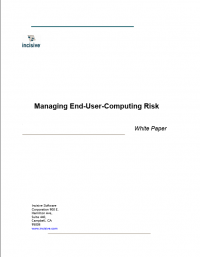
This document explains why End‑User Computing (EUC) applications—especially spreadsheets and related analytical files—are vital to enterprises yet pose significant risk if unmanaged. It emphasizes the need for an enterprise‑wide EUC Inventory, strong access controls, and continuous monitoring to ensure data accuracy, compliance, and trustworthy reporting.
As EUCs proliferate across departments and shared drives, manual oversight becomes impractical. The paper highlights how scattered files, unclear ownership, and ad‑hoc processes increase the likelihood of errors, overwrites, and unauthorized edits. It presents a practical approach to inventory, govern, and monitor EUC assets at scale. The guide covers:
Historical Perspective: EUCs have long underpinned decisions but are prone to version sprawl, hidden logic, and data inconsistencies that can lead to costly mistakes and regulatory penalties.
Emerging Concerns: Growing file volumes, broader user access, and tighter regulations demand automated discovery, risk assessment, and policy enforcement—anchored by a comprehensive EUC Inventory—rather than periodic, manual checks.
Action Points: Establish and maintain an EUC Inventory, apply permissioned check‑in/check‑out, track ownership and change history, collaborate between owners and auditors, and issue proactive risk alerts with standardized reporting.
Risk Management Framework: Build on four pillars—collaboration, management, control, and reporting—to deliver completeness, speed, accuracy, scalability, ease of use, rapid onboarding, and support for best practices.
For teams aiming to minimize EUC risk while strengthening data quality and audit readiness, this guide is an essential read.
